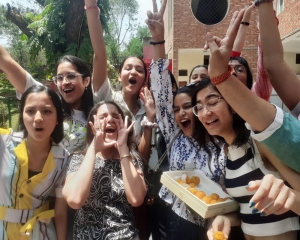Italian Michelin chef Beppe De Vito whizzed in and out of India but left behind a trail of a smooth whisky finish with his six-course dinner. Yes, there was Italian food too. Rinku Ghosh was at the table to witness a cuisine innovation that’s changing our familiar experiences for the future
Clearly, we weren’t prepared for this — a combination of lobster, pumpkin and fermented truffle had with a 15-year-old single malt. Clearly it defied all logic, grammar and imagination till a tentative nibble here and a shy sip there resulted in an unknown explosion of flavours. It all came together, the luscious prawns embedded in translucent tortelli, with a relish of Delica pumpkins, all caramelised and buttery, lifted like a magic carpet with the heather honey and vanilla fudge feel of the Glenfiddich 15 year-old. The lingering trail of sweetness left by each is the reason that the juicy lobster bursts forth in a gush of sealed-in flavours.
We never imagined the humble eggplant as an accompaniment of an 18-year-old single malt. Yet who would have thought that its warming and fruity aromatics and finish would invest the vegetable with such character and lend it enough courage to wipe off the smoked yolk sitting coyly around it? Such is the artistry by chef restaurateur Beppe De Vito, the Michelin-starred chef of his signature kitchen Braci, which has become somewhat of a Singaporean benchmark.
Beppe De Vito’s passion for food first began to take form while he was still a child, living in Italy and working at his neighbourhood cafe. All he remembers from those days is how we would source fresh, the fruit from a tree, the fish from a river, meat freshly cut by the butcher...something that dominates his produce-based kitchen even now. From then it was an around the world trip where he imbibed the spirit of a global traveller, collecting rich experiences and distilling them into his food. And it is because he values every distinct encounter that his commitment to his craft shines through, be it in the menu, to the design, service, the plating and beyond. So it is that on his India trip, he got the yeast which had been cultured for over 2,000 years in Italy to make a crispy, crunchy bread. And he loves not only serving food but reading your reaction to it. Over the years, he has had the opportunity to personally cook for local distinguished guests, which includes the late founding Prime Minster Lee Kuan Yew, President Tony Tan, Prime Minister Lee Hsien Loong, as well as foreign VIPs, such as former President Bush, Sting and many more. He has also collaborated on multiple four-hands dinners with respected Michelin star chefs from all over the world, from Chef Massimo Bottura (3 Michelin star), Chef Andrea Berton (2 Michelin star), Chef Tom Sellers (1 Michelin star), and world-renowned Chef Tetsuya Wakuda. But clearly he is not looking at VIPs. “They come to our restaurants always. Honestly, I am looking for someone who is just coming for fine dining for the first time ever and I can impress the person and that person will remember it forever,” says the maestro, who has made science look artful as never before.
Normally Italian food and flavours are always complemented with wine. People have that expectation... how difficult was it to work on a combination with whisky? What was the logic in your pairing as it seemed to work on similarities rather than contrasts?
I am always looking for new ways to experiment with unconventional ingredients. I have experimented with whisky pairings in the past and I find the flavours very versatile, which is why I enjoy using it so much. People have set expectations when it comes to Italian food especially, and to me, this is where I like to have fun and challenge people’s perceptions. When trying out new components, I always ask myself “how can this elevate my dishes” and “how does this take my cuisine to the next level?”
You’ve always blended your home country traditions into your food with hints and accents. Do you think progressive cuisine can actually save cooking traditions more effectively?
Traditions work well to set the foundations and essence of any strong cuisine but that does not mean they alone should define or limit a chef. Rather, they should be used as an inspirational tool for elevation. To me, modern Italian cuisine is one that honours classic traditions by exemplifying them through a contemporary lens in a way that brings out a dish’s full potential. This has always been the approach I have taken with my cuisine and one of the driving forces that conceptualised Braci as our culinary playground — creating a space where we could really dive into our craft and push the boundaries of the perceptions of Italian gastronomy. I focus on the essence of our very own version of Italian cuisine, which we are constantly dissecting and reinventing, through a contemporary lens. This keeps the spark of curiosity alive with diners, without compromising our identity and to me, is key to successful progressive cuisine —keeping traditions alive but constantly evolving.
What shaped your food logic while growing up? What are your inspirations? Any anecdotes to share?
My experiences at home, learning and observing the way people react to each dish. I find myself inspired by the places I’ve lived, the places I’ve travelled to and the different cultures I had the opportunity to learn about.
Nobody would usually think of a lobster with pumpkin relish... how much time and research goes into working these combinations in your menu?
My eyes and mind are always open for new ways to be inspired. I get many customers coming to me and telling me how intrigued they are with some of the combinations of my dishes. Inspiration is not much of an issue for me, but the execution does take a little more thought and experimentation. With my cuisine at Braci, I really do look for ways to keep things as simple as possible when it comes to presentation and the number of components of my dishes, but it is important to me that each element of my dishes makes a powerful impact, which is why I like to experiment with unusual combinations. The process can be lengthy at times but it is always rewarding once you’ve created something that makes customers light up.
How do you adapt your dishes to local ingredients while travelling? Any Indian spices or dish that may have caught your fancy?
I am always inspired by my travels. New sights, smells, sounds, conversations and emotions. I am inspired by everything; traditions, flavours, sourcing of ingredients and, of course, how cultures respect their produce. Japan, in particular, is a place that I always find myself going back to — I love the respect the people have for seasonal and quality ingredients and is something I very much ascribe to in my own cuisine and Italian traditions. The Japanese minimalist philosophy is also something I find myself reinforcing. Sometimes a dish can appear simple, elegant and beautiful, but there is so much technique behind it, and it is definitely quality over quantity when it comes to this school of thought. Japan is one of my favourite locations to travel. I will go there six-seven times a year and always come back with new ideas and ingredients I want to implement in my dishes, which is why our menu is continually evolving.
I like to adapt elements from travels within my cuisine in a way that makes a dish their own as opposed to fusion cuisine. To me, inspiration is about taking in the best from all around you and making things your own. We didn’t use any Indian spice in our menu but we had the opportunity to learn about some fantastic spices in India and will incorporate this knowledge for future recipes. Before returning to Singapore, we went to a spice bazaar and bought quite a bunch, including green and black cardamom. Green cardamom is very hard to find in Singapore. We also took back saffron and star anise, which is much sweeter and aromatic than ingredients used in Italian cuisine.
Which cuisine in the world would you say comes closest to the perfect sensory and nutritional balance?
Italian and Japanese. Especially the cuisine from southern Italy, which is always seasonal, uses only fresh ingredients, is light and well-balanced.
With a Lancet study predicting a shortage of livestock and animal protein by 2050 and advising rationing, how will the way we eat food change? As a chef, where do you see the global food movement heading to?
We are living in a fascinating time for food; faced with challenges and innovations that we’ve never seen before. People these days are now open to more options than ever when it comes to cuisines, diets and even sustainability, all of which have a role to play in the global food movement. Sustainability, in particular, is something I foresee becoming very popular in the culinary world and is something that we are already implementing at Braci — finding ways to use sustainable cooking methods in ways that elevate our dishes. For example, our popular Roasted Pigeon with Green Asparagus and Sumac is made by utilising the whole bird. With meatless movements becoming so prominent, I have also made it a point to provide vegetarian and vegan options across all of my menus, without compromising on quality and to me, that is an opportunity to get creative.
What is your guilty pleasure and what is your at-home meal?
Caviar. On very special occasions I feed it to my children as well. Otherwise, we eat quite simply, but always organic with a lot of different vegetables and good Japanese brown rice.
How do you make the most humble vegetable exotic?
You must know your produce inside out and never turn your nose up on ingredients. The simplest things in life turn out to be the most incredible, and the same goes with food. You have to find ways to make ingredients bring out the best out of each other, and even the most humble vegetable can have one element within it that can be transformed and reinvented. It can also do the same for the most prestigious of ingredients. It is important to keep your mind open to everything when it comes to produce and elevating cuisine — the most humble vegetable could be a hidden gem.
A good trick is to create several textures from the same ingredient. For instance, we may cut the best part and blanch it or grill it while making a creamy sauce with the trimmings, and pickle other parts to make a tart pesto.


























